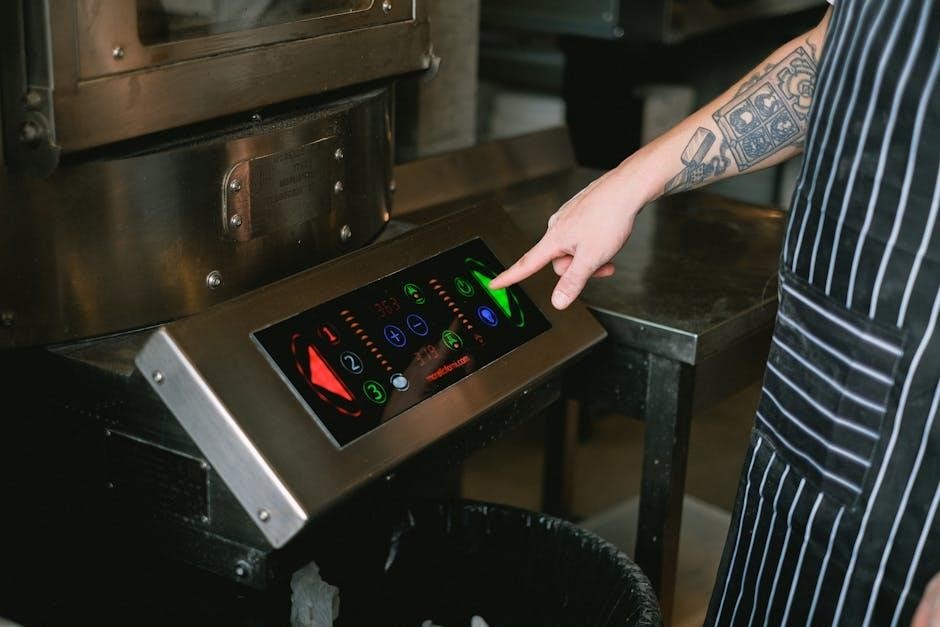honeywell 5000 programming manual

The Honeywell 5000 Programming Manual provides a comprehensive guide for installers and users to configure and optimize the thermostat’s advanced features. It covers installation‚ programming‚ and troubleshooting‚ ensuring efficient and personalized climate control. This manual is essential for maximizing the thermostat’s energy-saving capabilities and integrating it with smart home systems.
Overview of the Honeywell 5000 Series
The Honeywell 5000 Series‚ part of the FocusPRO™ lineup‚ offers a range of programmable and non-programmable thermostats designed for efficiency and user convenience. These thermostats are compatible with various HVAC systems‚ including heat pumps and dual-fuel systems‚ ensuring versatile installation options. With a user-friendly interface‚ the series provides intuitive control over temperature settings‚ scheduling‚ and energy-saving features. The FocusPRO™ TH5000 Series‚ in particular‚ is known for its digital precision and advanced functionality‚ making it a popular choice for both residential and light commercial applications. Its robust design and compatibility with smart home systems further enhance its appeal for modern users seeking seamless climate control solutions.
Importance of Programming in Thermostat Functionality
Programming is essential for optimizing the Honeywell 5000 Series thermostat’s performance‚ enabling users to tailor temperature settings to their lifestyle. By setting daily schedules‚ users can save energy and enhance comfort. Advanced features like smart recovery and geofencing rely on precise programming to function effectively. Additionally‚ programming allows for customization of security codes‚ lockout times‚ and relay outputs‚ ensuring system safety and efficiency. Proper programming also enables seamless integration with smart home systems‚ offering remote control and real-time adjustments. This level of customization ensures the thermostat operates efficiently‚ providing consistent and personalized climate control while minimizing energy consumption.
Key Features of the Honeywell 5000 Series Thermostat
The Honeywell 5000 Series thermostat offers advanced features designed for optimal performance and user convenience. It includes customizable daily schedules‚ smart recovery capabilities‚ and energy-saving modes. The thermostat also supports geofencing‚ allowing location-based temperature adjustments. Security features like user codes and lockout times enhance system protection. Additionally‚ it provides seamless integration with smart home systems for remote control and monitoring. The thermostat’s interface is user-friendly‚ making it easy to navigate and configure settings. With built-in compressor protection and compatibility with various HVAC systems‚ the Honeywell 5000 Series ensures efficient and reliable operation‚ catering to diverse heating and cooling needs.

System Requirements and Compatibility
The Honeywell 5000 Series thermostat requires compatible HVAC systems and meets electromagnetic compatibility standards. It operates efficiently across specified environmental conditions‚ ensuring reliable performance and safety.
Compatibility with HVAC Systems
The Honeywell 5000 Series thermostat is designed to work seamlessly with various HVAC systems‚ including heat pumps‚ gas furnaces‚ and air conditioning units. It supports 2Heat/1Cool and 3Heat/2Cool configurations‚ ensuring flexibility for different home setups. The thermostat is also compatible with emergency heat systems‚ requiring specific wiring configurations for optimal performance. Proper installation and setup ensure that the thermostat integrates smoothly with existing HVAC equipment‚ providing efficient temperature control and energy savings. Compatibility with these systems is crucial for maintaining reliable operation and maximizing the thermostat’s advanced features.
System Requirements for Installation
The Honeywell 5000 Series thermostat requires specific system configurations for proper installation. It supports systems like 2Heat/1Cool and 3Heat/2Cool‚ including heat pumps and emergency heat setups. The thermostat must be connected to a 24V AC power supply‚ and wiring should follow the manufacturer’s guidelines to ensure compatibility. For systems without an emergency heat relay‚ a field jumper between Aux and E terminals is necessary. Proper installation also involves setting the system type in Installer Setup‚ such as selecting heat pump or conventional HVAC configurations. Adhering to these requirements ensures reliable operation and optimal performance of the thermostat.
Supported Thermostat Models and Versions
The Honeywell 5000 Series supports models such as the FocusPRO™ TH5000 and TH5000 Series digital thermostats. These models are compatible with a wide range of HVAC systems‚ including heat pumps and conventional systems. The manual covers configurations for 2Heat/1Cool‚ 3Heat/2Cool‚ and heat pump systems‚ ensuring versatility for various installations. Specific versions of the thermostat‚ such as those with built-in compressor protection‚ are also detailed in the manual. Compatibility with emergency heat relays and auxiliary functions is addressed‚ providing a comprehensive guide for installers to ensure proper setup and operation across different Honeywell 5000 models and versions.

Installation and Setup
The Honeywell 5000 Series installation involves pre-installation checks‚ wiring‚ and initial configuration. The process is streamlined for compatibility with various HVAC systems‚ ensuring a smooth setup experience.
Pre-Installation Checks
Before installing the Honeywell 5000 Series Thermostat‚ ensure compatibility with your HVAC system and verify electrical requirements. Check for existing wiring compatibility and any necessary field jumpers. Review system type settings‚ such as heat pump configurations‚ to match your equipment. Ensure the thermostat’s relay outputs align with your system’s demands. Also‚ verify if emergency heat relays are present or if field jumpers between Aux and E are needed. These checks ensure a smooth installation process and prevent potential issues during setup. Proper preparation guarantees optimal performance and compatibility‚ making the installation process efficient and stress-free.
Step-by-Step Installation Guide
Start by turning off the power to your HVAC system at the circuit breaker. Remove the old thermostat and take note of the wiring configuration. Mount the Honeywell 5000 Series Thermostat base plate to the wall‚ ensuring it is level and secure. Connect the wires to the appropriate terminals (R‚ W‚ Y‚ G‚ C‚ and Aux/E) as per the wiring guide. Install the field jumper between Aux and E if no emergency heat relay is present. Set the system type in Installer Setup to match your HVAC configuration (e.g.‚ 2Heat/1Cool Heat Pump). Finally‚ restore power and perform system tests to ensure proper operation.
Wiring Guidelines for Honeywell 5000 Series
Ensure the power to your HVAC system is off before starting. Refer to the wiring guide for the Honeywell 5000 Series to identify the correct terminals (R‚ W‚ Y‚ G‚ C‚ and Aux/E). Connect the wires to the corresponding terminals on the thermostat base plate. If your system lacks an emergency heat relay‚ install a field jumper between the Aux and E terminals. For heat pumps‚ configure the system type in Installer Setup (e.g.‚ 2Heat/1Cool or 3Heat/2Cool). Verify all connections are secure and match your HVAC system’s requirements. After wiring‚ restore power and test the system to ensure proper functionality.
Initial System Configuration
After installation‚ access the Installer Setup menu to configure the system type (e.g.‚ 2Heat/1Cool or 3Heat/2Cool). Set the changeover mode to Manual or Auto based on your HVAC system; For heat pumps‚ enable auxiliary heat if required. Configure the number of heating and cooling stages. Set the compressor protection time to prevent damage. Enable smart recovery for energy efficiency. Save the settings and exit the Installer Setup. Test the system by running a quick test cycle. Ensure all features like geofencing and smart alerts are enabled. This initial setup ensures optimal performance and prepares the thermostat for advanced programming features.

Programming the Thermostat
Programming the Honeywell 5000 thermostat involves setting a master code‚ user codes‚ and configuring relay outputs. It also includes advanced features like smart recovery and geofencing for optimal performance.
Understanding the Programming Interface
The Honeywell 5000 programming interface is designed for intuitive navigation‚ offering a user-friendly keypad and menu system. It allows users to easily access and adjust settings‚ schedules‚ and advanced features. The interface includes function buttons for quick operations‚ such as setting daily schedules or adjusting relay outputs. With clear labels and organized menus‚ the system simplifies complex programming tasks. Features like smart recovery and geofencing are seamlessly integrated‚ ensuring optimal performance. The interface also supports security settings‚ enabling users to set master and user codes for restricted access. This design ensures that both beginners and advanced users can efficiently program and customize their thermostat.
Setting Up Daily Schedules
Setting up daily schedules on the Honeywell 5000 thermostat allows users to customize temperature settings according to their routine. The thermostat supports multiple periods per day‚ enabling precise control over heating and cooling. Users can program different temperatures for wake‚ leave‚ return‚ and sleep times. The interface guides users through each step‚ ensuring schedules are set accurately. The thermostat retains these settings until the next programmed change‚ providing consistent comfort. Additionally‚ features like hold and override options offer flexibility for unexpected changes. This scheduling capability is essential for optimizing energy usage and maintaining a comfortable environment throughout the day.
Programming User Codes and Security Features
Programming user codes and security features on the Honeywell 5000 thermostat enhances system protection and customization. Users can set a personal master code and additional user codes (1 and 2) to restrict access. These codes ensure only authorized individuals can modify settings. The thermostat also supports relay output programming‚ allowing control over specific functions like lockout time. Security features include keypad lockout and password protection‚ preventing unauthorized changes. These options provide flexibility while maintaining system integrity. By programming user codes and security settings‚ users can tailor the thermostat’s functionality to their needs while safeguarding against unintended adjustments. This ensures a secure and personalized experience;
Configuring Relay Outputs and Functions
Configuring relay outputs on the Honeywell 5000 thermostat allows precise control over HVAC system operations. Relays can be programmed to activate specific functions‚ such as heating‚ cooling‚ or emergency heat‚ based on system requirements. The L terminal‚ for instance‚ provides continuous output when emergency heat is enabled. Installers can set field jumpers between Aux and E terminals if no emergency heat relay is present. These configurations ensure seamless communication between the thermostat and HVAC components‚ optimizing performance. Proper setup of relay outputs is crucial for reliable system operation and energy efficiency. This step ensures all components work together harmoniously to maintain desired conditions.
Advanced Programming Features
The Honeywell 5000 thermostat offers advanced programming features for enhanced control and efficiency. These include smart recovery‚ which learns and adjusts heating/cooling times for optimal energy use‚ and geofencing‚ enabling location-based temperature adjustments. Customizable system alerts notify users of maintenance needs or extreme temperatures. The thermostat also supports integration with smart home systems‚ allowing seamless voice or app control. Advanced features like compressor protection ensure long-term system reliability. The manual provides detailed guidance on configuring these settings‚ ensuring compatibility with various HVAC systems. By leveraging these features‚ users can achieve greater comfort and energy savings while maintaining system performance and longevity.

Troubleshooting Common Issues
This section provides guidance on identifying and resolving common programming errors‚ connectivity problems‚ and malfunctions related to schedules‚ timers‚ and relay outputs in the Honeywell 5000 thermostat. It offers practical steps to restore functionality and ensure optimal performance.
Identifying Common Programming Errors
Common programming errors in the Honeywell 5000 thermostat often stem from incorrect system configuration or scheduling conflicts. Issues like improper relay output settings or mismatched user codes can disrupt operation. Additionally‚ errors may arise from outdated firmware or incorrect jumper installations. Users should verify all programmed settings against the manual to ensure compatibility with their HVAC system. Regularly reviewing the thermostat’s event history and error logs can help pinpoint issues. Addressing these problems early prevents system downtime and ensures reliable performance. Always refer to the troubleshooting section for detailed solutions and best practices to resolve programming errors effectively.
Resolving Connectivity Issues
Connectivity issues with the Honeywell 5000 thermostat can often be resolved by checking the system’s network settings and ensuring proper Wi-Fi configuration. Power cycling the thermostat or restarting the router may restore connectivity. Verify that the thermostat is connected to the correct network and that the Wi-Fi credentials are accurate. If issues persist‚ ensure the thermostat’s firmware is up to date‚ as outdated software can cause connection problems. Additionally‚ check for any physical obstructions or interference that may affect the signal strength. Refer to the user manual for specific troubleshooting steps or contact Honeywell support for further assistance if needed.
Fixing Schedule and Timer Malfunctions
If the Honeywell 5000 thermostat’s schedule or timer isn’t functioning correctly‚ start by verifying the programmed settings. Ensure the daily schedule is correctly configured‚ and the timer aligns with the desired operation. Restart the thermostat by removing it from power for 30 seconds and reconnecting it. Check that the time and date are accurate‚ as incorrect settings can disrupt scheduling. Review the user manual for specific instructions on resetting or reprogramming the schedule. If issues persist‚ consult the troubleshooting section or contact Honeywell support for assistance in resolving the malfunction and restoring proper functionality.
Addressing Relay Output Problems
To resolve relay output issues with the Honeywell 5000 thermostat‚ first ensure proper wiring connections according to the FocusPRO TH5000 Series wiring guide. Verify that field jumpers are correctly installed‚ such as between Aux and E if emergency heat is not used. Check the system type configuration in Installer Setup to match your HVAC system. Ensure relay outputs are programmed correctly for functions like heat‚ cool‚ or emergency heat. If issues persist‚ consult the troubleshooting section of the manual or contact Honeywell support for further assistance. Proper configuration ensures reliable operation and prevents system malfunctions.

Advanced Features and Customization
The Honeywell 5000 Series offers advanced features like geofencing‚ smart recovery‚ and energy-saving modes. Users can customize system alerts‚ integrate with smart home systems‚ and optimize schedules for enhanced efficiency and convenience.

Geofencing and Location-Based Programming
Geofencing allows the Honeywell 5000 thermostat to adjust settings based on your location. When you leave or enter a set area‚ the system automatically changes temperatures‚ optimizing energy use. This feature ensures your home is comfortable when you arrive and saves energy when you’re away. Location-based programming integrates with smart devices‚ enabling seamless control through your smartphone. By setting up geofences‚ you can create a personalized experience that enhances convenience and efficiency‚ making it easier to manage your home’s climate without manual adjustments.
Smart Recovery and Energy-Saving Features
The Honeywell 5000 thermostat includes smart recovery and energy-saving features to optimize heating and cooling. Smart recovery learns your schedule and preferences‚ gradually adjusting temperatures to meet your comfort needs while minimizing energy use. Energy-saving modes reduce consumption during periods of inactivity or when you’re away. The thermostat also provides detailed energy reports‚ helping you identify usage patterns and make informed decisions. These features work seamlessly with geofencing and location-based programming‚ ensuring your system operates efficiently and effectively‚ cutting energy costs without compromising comfort.
Customizing System Alerts and Notifications
The Honeywell 5000 thermostat allows users to customize system alerts and notifications‚ ensuring you stay informed about important system events. You can set preferences for notifications related to temperature changes‚ system errors‚ or maintenance reminders. These alerts can be tailored to specific conditions‚ such as when the temperature deviates from the setpoint or when a system issue arises. Customizable notifications enhance your ability to monitor and control your HVAC system efficiently. The thermostat’s user interface simplifies the process of enabling or disabling alerts‚ providing a seamless experience for maintaining optimal comfort and system performance.
Integrating with Smart Home Systems
The Honeywell 5000 thermostat seamlessly integrates with popular smart home systems‚ enhancing your ability to control temperature settings remotely. Compatibility with platforms like Samsung SmartThings and other Zigbee or Z-Wave enabled systems allows for centralized home automation. Users can synchronize their thermostat with smart devices‚ enabling voice control through assistants like Amazon Alexa or Google Assistant. This integration also supports geofencing‚ adjusting temperatures based on your location. By connecting to your smart home network‚ you can access advanced features such as energy usage tracking and automated adjustments for optimal comfort and efficiency. This connectivity ensures a unified and intelligent home environment.

Technical Specifications and Safety

The Honeywell 5000 series operates on 24V AC with a 20mA maximum current draw. It meets EMC standards and requires compliance with local electrical codes for safe installation.
Electrical Requirements and Safety Precautions
The Honeywell 5000 Series requires a 24V AC power supply‚ with a maximum current draw of 20mA. Ensure all wiring connections are secure and comply with local electrical codes. Before installation‚ disconnect power to avoid electrical shock. Use appropriately rated wires and follow grounding instructions to prevent damage or hazards. Keep the thermostat away from direct water exposure and extreme temperatures. Adhere to safety standards to ensure reliable performance and user protection. Always refer to the manual for specific voltage and current requirements to maintain system integrity and safety during operation.
Compliance with Electromagnetic Compatibility Standards
The Honeywell 5000 Series is designed to comply with electromagnetic compatibility (EMC) standards‚ ensuring minimal interference with other electronic devices. It adheres to regulations such as EN 61000-4-2 for electrostatic discharge and EN 61000-4-3 for radiated electromagnetic fields. Proper installation‚ as outlined in the manual‚ is crucial to maintain compliance. The thermostat is tested to withstand common electromagnetic disturbances‚ ensuring reliable operation in various environments. By meeting these standards‚ the Honeywell 5000 Series provides a robust and interference-free performance‚ contributing to overall system reliability and safety.
Environmental Operating Conditions
Honeywell 5000 thermostats are designed to operate effectively within specific environmental conditions. The recommended operating temperature range is 32°F to 122°F (0°C to 50°C)‚ with a storage temperature range of -4°F to 140°F (-20°C to 60°C). Relative humidity should not exceed 80% for reliable performance. Additionally‚ the thermostat should be installed in a location protected from direct sunlight‚ moisture‚ and extreme temperature fluctuations to ensure optimal functionality. Compliance with these environmental guidelines ensures the thermostat’s longevity and efficiency in maintaining consistent indoor climate control.

User Guide and Reference
The Honeywell 5000 User Guide provides detailed instructions for navigating the thermostat’s interface‚ customizing settings‚ and troubleshooting common issues. It serves as a handy reference for both novice and advanced users‚ ensuring optimal performance and energy efficiency.
Navigating the Honeywell 5000 User Interface
Navigating the Honeywell 5000 thermostat interface is intuitive‚ with a user-friendly design that simplifies programming and daily use. The interface features a clear display and function buttons that guide users through menu options. Key sections include scheduling‚ system settings‚ and energy-saving features. Users can easily access advanced settings like relay outputs and security codes through the installer setup menu. The interface also provides real-time feedback‚ ensuring adjustments are made accurately. This seamless navigation enhances the overall user experience‚ making it easy to customize and monitor heating and cooling systems efficiently.
Reference Manual for Advanced Users
The reference manual for advanced users provides in-depth technical details for optimizing the Honeywell 5000 thermostat. It includes detailed schematics‚ wiring diagrams‚ and advanced programming techniques. Users can explore custom configurations‚ such as geofencing and smart recovery‚ to enhance energy efficiency. The manual also covers troubleshooting complex issues and integrating with smart home systems. Advanced users will find comprehensive guides on relay output customization and security feature programming. This resource is tailored for those seeking to maximize the thermostat’s capabilities‚ offering detailed insights and expert-level instructions for seamless system integration and optimal performance.
Online Resources and Support
For comprehensive support‚ visit yourhome.honeywell.com‚ which offers detailed guides‚ troubleshooting tips‚ and FAQs. The FocusPRO 5000 Series User Guide provides step-by-step instructions for advanced users. Additional resources include the Honeywell 5000 Programming Manual and the FocusPRO TH5000 Reference Manual‚ available for download. Online forums and technical support teams are also accessible for personalized assistance. These resources ensure users can resolve issues and maximize their thermostat’s functionality efficiently. Page 22 of the FocusPRO TH5000 Manual highlights key troubleshooting steps‚ while the GlobalPOS-GPC_5000-User-Manual.pdf offers insights into system compatibility and installation.
The Honeywell 5000 Programming Manual is a valuable resource for optimizing thermostat functionality. It provides comprehensive guidance‚ ensuring efficient and energy-saving performance through detailed instructions and troubleshooting support.
The Honeywell 5000 Programming Manual highlights features like daily scheduling‚ user code security‚ and relay output configuration. It also covers geofencing‚ smart recovery‚ and customizable alerts. These tools enable precise temperature control‚ energy savings‚ and seamless smart home integration‚ ensuring optimal performance tailored to user needs.
Best Practices for Optimal Performance
To ensure optimal performance of the Honeywell 5000 thermostat‚ follow these best practices:
– Regularly update the thermostat’s software to access the latest features and security patches.
– Ensure proper wiring during installation to avoid connectivity issues.
– Set up daily schedules and geofencing to optimize energy usage.
– Periodically review and adjust user codes for enhanced security.
– Use the smart recovery feature to balance comfort and energy savings.
– Check system compatibility before integrating with smart home devices.
– Perform a power cycle (reset) to resolve minor malfunctions.
– Consult the manual for troubleshooting common programming errors.
These practices ensure seamless functionality and energy efficiency.
Future Updates and Enhancements
Honeywell continuously innovates to enhance the 5000 series’ performance and user experience. Future updates may include advanced AI-driven scheduling‚ voice command integration‚ and enhanced smart home compatibility. Security features will be strengthened with biometric authentication and real-time alerts. Energy-saving modes will be optimized using machine learning to adapt to usage patterns. Additionally‚ remote firmware updates will ensure the thermostat stays up-to-date with the latest technologies. Users can expect expanded compatibility with emerging smart home platforms‚ improving seamless integration. Regularly checking for updates via Honeywell’s official channels is recommended to leverage these advancements and maintain optimal functionality.